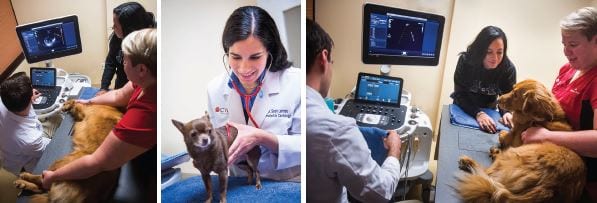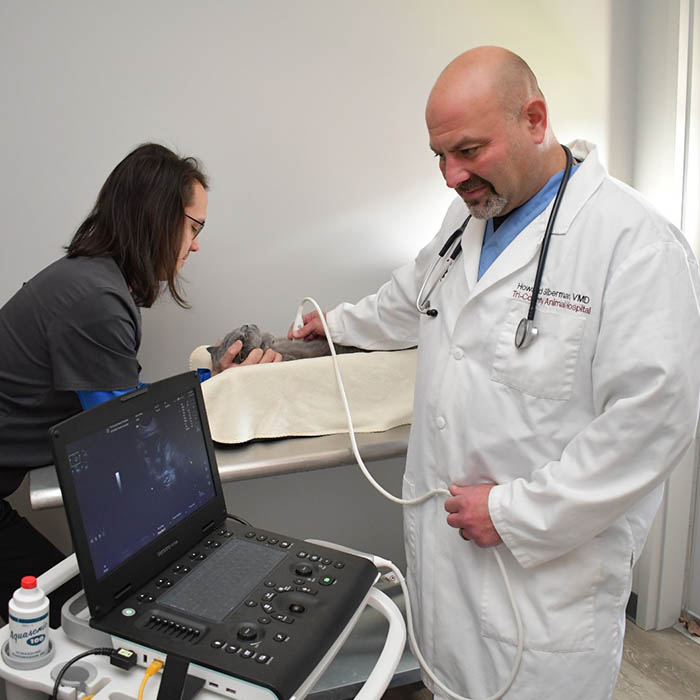What You Required to Know About Vet Providers: A Review of Diagnostic Devices and Procedures
Vet solutions play a crucial function in keeping the health of pets. Regular exams can disclose concealed health and wellness issues at an early stage. Various analysis devices and procedures, such as blood tests and imaging strategies, supply necessary insights right into a pet's well-being. Understanding these approaches is crucial for animal proprietors. What certain analysis treatments are most typically used, and exactly how can they affect a pet's therapy plan?
Relevance of Routine Vet Examinations
While many pet dog owners might ignore the significance of normal veterinary exams, these visits are essential for preserving an animal's general health. Regular visits to the veterinarian permit early discovery of potential wellness issues before they rise into severe problems. Routine exams commonly consist of vaccinations, which are very important for protecting against transmittable diseases that might seriously affect a pet's well-being. Furthermore, these consultations offer a chance for vets to assess the animal's weight, dental health and wellness, and total condition, guaranteeing that the family pet is growing. During these check outs, family pet proprietors can additionally receive important guidance on diet regimen, workout, and preventive care tailored to their specific animal's needs.
Typical Diagnostic Treatments in Vet Medication
In vet medication, precise diagnosis is crucial for effective treatment. Common analysis treatments consist of blood screening methods, advanced imaging innovations, and urinalysis, each playing a considerable function in identifying health issues. Understanding these methods boosts the capacity to supply ideal take care of pet individuals.
Blood Checking Strategies
Blood screening methods serve as vital diagnostic tools in vet medicine, enabling vets to analyze the health and wellness of animals precisely. These methods involve accumulating blood samples to analyze numerous elements, such as red and white blood cells, platelets, and biochemical markers. Common tests include full blood counts (CBC), which evaluate total health and spot infections, and biochemical panels, which evaluate organ function and metabolic standing. Additionally, serological examinations can determine specific diseases via antibody detection. Blood testing is minimally invasive and supplies crucial information that assists in diagnosing problems, checking health and wellness standing, and examining reactions to therapies. In general, these strategies play an essential function in ensuring ideal take care of pet dogs and livestock alike.
Imaging Technologies Made Use Of
Diagnostic imaging innovations are crucial tools in veterinary medication, enhancing blood screening techniques by supplying aesthetic understandings right into an animal's internal structures. Typical imaging methods consist of X-rays, which are helpful for examining bone cracks and detecting foreign items, and ultrasound, which enables real-time visualization of soft cells and body organs. Magnetic vibration imaging (MRI) supplies comprehensive photos of complicated physiological locations, specifically in neurological evaluations. Computed tomography (CT) offers cross-sectional pictures, improving analysis precision for various problems. Each of these technologies help vets in detecting ailments, intending therapies, and monitoring recovery. By incorporating imaging modern technologies, vet experts can better evaluate an animal's health and make informed choices concerning their care.
Urinalysis and Diagnostics
Urinalysis functions as a crucial diagnostic tool in veterinary medicine, providing beneficial understandings into an animal's total health and wellness and helping in the detection of numerous conditions. This non-invasive procedure assesses pee samples to examine kidney function, hydration status, and metabolic disorders. Common parts analyzed include details gravity, pH levels, sugar, healthy proteins, and the presence of blood or microorganisms. Unusual findings can suggest issues such as urinary system tract infections, diabetic issues mellitus, or kidney disease. To boost diagnostic precision, urinalysis is usually carried out combined with various other tests, such as blood job and imaging research studies. Early discovery through urinalysis can cause timely interventions, enhancing the diagnosis for numerous vet patients. It is a vital aspect of complete vet care.
Comprehending Blood Examinations and Laboratory Analysis
Comprehending blood tests and lab evaluation is vital in veterinary medicine as it assists in diagnosing different wellness problems in animals. Different sorts of blood examinations give vital details about an animal's interior state, while translating laboratory results calls for mindful consideration of numerous elements. This section will check out the kinds of blood examinations readily available and the significance of their results.
Kinds of Blood Examinations
Blood examinations play an important role in veterinary medicine, providing essential understandings right into a pet's wellness standing. Different kinds of blood examinations are used, each serving different purposes. Complete blood matters (CBC) analyze total wellness and find problems such as anemia or infection. Biochemical profiles assess organ feature by gauging electrolytes and enzymes, supplying understandings into metabolic health and wellness. Serological examinations identify details antibodies or microorganisms, aiding in the medical diagnosis of infections or autoimmune conditions. Blood inputting warranties secure transfusions, while coagulation examinations assess the blood's ability to embolisms, essential for procedures. These tests jointly enhance medical diagnosis, therapy planning, and surveillance of a pet's health, highlighting the relevance of complete lab evaluation in veterinary care.

Analyzing Laboratory Results
An extensive analysis of lab results is important for precise diagnosis and therapy in vet medicine. Interpreting laboratory results calls for an understanding of typical reference ranges and the significance of deviations. Blood examinations can expose various health indications, such as organ function, electrolyte equilibrium, and the presence of infections. Vets need to think about the entire professional photo, including the animal's background, physical assessment findings, and any kind of signs presented. Variants in results might occur from variables such as age, breed, and underlying health problems. Laboratory results must not be viewed in isolation however instead as part of a comprehensive diagnostic technique. Accurate interpretation permits for tailored treatment strategies and better results for veterinary clients.
Imaging Techniques: X-rays, Ultrasounds, and Beyond
Imaging methods are essential tools in vet medication, providing important understandings into the health and wellness and health of pets. Among the most frequently made use of methods are X-rays and ultrasounds. X-rays are very useful for imagining bone structures, assisting vets recognize cracks, tumors, or foreign objects. This method is fast and non-invasive, making it perfect for urgent situations.Ultrasounds, on the other hand, use audio waves to create images of soft tissues and body organs. This technique is particularly helpful for taking a look at the heart, abdominal area, and reproductive organs, enabling veterinarians to evaluate conditions like fluid buildup or organ abnormalities.Beyond X-rays and ultrasounds, advanced imaging strategies such as computed tomography (CT) and magnetic vibration imaging (MRI) are significantly made use of in vet method. These techniques provide comprehensive cross-sectional images, enhancing the precision of medical diagnoses and treatment plans. Cancer Veterinary Near Me. Overall, imaging strategies play have a peek at these guys a crucial duty in making sure efficient veterinary treatment
The Role of Biopsies in Diagnosing Pet Wellness Issues
Accuracy in diagnosing wellness concerns in family pets typically hinges on the usage of biopsies, which supply definitive information regarding tissue problems. A biopsy includes the elimination of a little sample of cells for examination under a microscopic lense, enabling vets to determine various problems, consisting of infections, tumors, and inflammatory illness. This analysis tool is essential for comparing malignant and benign developments, guiding therapy decisions, and examining the severity of a condition.Biopsies can be done using different techniques, such as needle ambition, incisional biopsies, or excisional biopsies, relying on the location and sort of cells entailed. The choice of technique might affect healing time and the quantity of tissue gathered. Inevitably, the information gleaned from a biopsy can cause targeted treatments, improving results for pet dogs facing major health and wellness obstacles. Veterinarians highlight the significance of this procedure in accomplishing exact medical diagnoses and effective treatment plans.
Advanced Diagnostic Equipment: Endoscopy and CT Scans

Advanced analysis devices, such as endoscopy and CT scans, play a crucial duty in modern-day vet medicine, offering non-invasive approaches to envision interior structures and diagnose numerous problems in animals. Endoscopy involves making use of a flexible tube outfitted with a camera, allowing vets to analyze the gastrointestinal system and breathing system directly. This strategy can expose abnormalities such as lumps, international bodies, or inflammation, making it possible for targeted treatment plans.CT scans, on the other hand, make use of advanced imaging modern technology to produce here are the findings detailed cross-sectional photos of the body (Cancer Veterinary Near Me). This approach is particularly valuable for assessing facility structures like the mind, spine, and joints. By supplying high-resolution images, CT scans help veterinarians in determining concerns that may not be noticeable through typical radiography. Together, these sophisticated devices enhance analysis accuracy, boost treatment outcomes, and inevitably contribute to much better total pet health and wellness monitoring

Translating Examination Results: What Pet Owners Need To Know
Comprehending examination results can be a challenging task for pet proprietors, especially after advanced procedures like endoscopy and CT scans have actually been performed. Translating these outcomes requires an understanding of medical terms and a clear understanding of what the searchings for suggest concerning the animal's wellness. Veterinarians usually offer descriptions, but the complexity of the outcomes can still lead to confusion.Pet proprietors need to actively involve in discussions with their veterinarians, asking concerns to make clear any type of unpredictabilities. It is vital to comprehend regular versus abnormal outcomes and the implications for the family pet's therapy strategy. Additionally, acknowledging that some outcomes might call for more testing or monitoring can assist proprietors remain educated about their pet's health and wellness journey. Eventually, a joint approach between pet owners and veterinary experts promotes much better health and wellness end results and boosts the total treatment experience for pet dogs.
Regularly Asked Inquiries
How Do I Choose the Right Veterinary Clinic for My Pet?
Picking the right vet facility includes looking into regional options, reviewing qualifications, seeing centers, and assessing personnel interactions (Ultrasound For Dogs). Focusing on referrals from relied on sources can help assure the ideal treatment and atmosphere for a pet's wellness demands
What Should I Do if My Family Pet Refuses to Go to the Veterinarian?
When a family pet refuses to head to the veterinarian, it's recommended to remain tranquil, use deals with or playthings to entice them, and take into consideration arranging a home check out if anxiety continues. Patience and favorable support are key.
Exist Telehealth Options for Veterinary Solutions?
Telehealth alternatives for veterinary services are significantly readily available, permitting family pet owners to seek advice from veterinarians from another location. These solutions allow discussions concerning wellness worries, guidance on minor disorders, and follow-ups without requiring to go to a clinic.
Just how Typically Should My Animal Have Dental Exams?
The frequency of oral examinations for animals normally depends on their age and breed. Generally, hop over to these guys vets recommend yearly dental evaluations, although some pet dogs may need more constant check outs to maintain excellent oral health.

What Are the Prices Linked With Veterinary Diagnostics?
The costs connected with vet diagnostics can differ commonly, generally ranging from standard tests like blood work to innovative imaging strategies. Aspects influencing expenditures consist of the clinic's area, devices used, and specific examinations required for each and every family pet. Veterinary solutions play a crucial duty in preserving the health of pet dogs. While lots of pet proprietors may take too lightly the relevance of regular vet check-ups, these consultations are necessary for maintaining a pet's overall wellness. Additionally, these consultations provide a possibility for veterinarians to examine the pet's weight, dental wellness, and overall problem, ensuring that the family pet is thriving. Accuracy in identifying health and wellness issues in pets typically pivots on the use of biopsies, which supply clear-cut information regarding cells abnormalities. Furthermore, identifying that some results may need more screening or monitoring can assist proprietors remain educated about their animal's wellness trip.